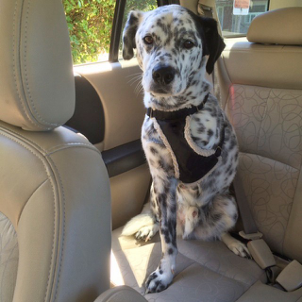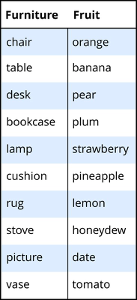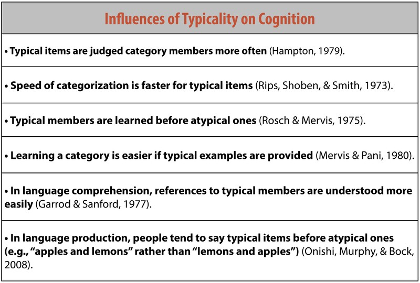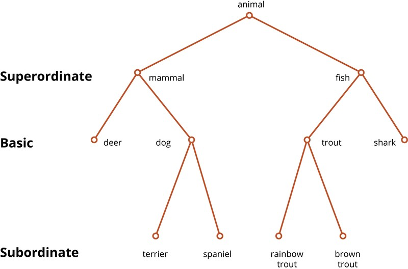12.3: Concepts and Categories
- Last updated
- Save as PDF
- Page ID
- 54132

- Mehgan Andrade and Neil Walker
- College of the Canyons
Categories
A category a set of objects that can be treated as equivalent in some way. For example, consider the following categories: trucks, wireless devices, weddings, psychopaths, and trout. Although the objects in a given category are different from one another, they have many commonalities. When you know something is a truck, you know quite a bit about it. The psychology of categories concerns how people learn, remember, and use informative categories such as trucks or psychopaths. The mental representations we form of categories are called concepts. There is a category of trucks in the world, and you also have a concept of trucks in your head. We assume that people’s concepts correspond more or less closely to the actual category, but it can be useful to distinguish the two, as when someone’s concept is not really correct.

Consider the following set of objects: some dust, papers, a computer monitor, two pens, a cup, and an orange. What do these things have in common? Only that they all happen to be on my desk as I write this. This set of things can be considered a category, a set of objects that can be treated as equivalent in some way. But, most of our categories seem much more informative— they share many properties. For example, consider the following categories: trucks, wireless devices, weddings, psychopaths, and trout. Although the objects in a given category are different from one another, they have many commonalities. When you know something is a truck, you know quite a bit about it. The psychology of categories concerns how people learn, remember, and use informative categories such as trucks or psychopaths.
The mental representations we form of categories are called concepts. There is a category of trucks in the world, and I also have a concept of trucks in my head. We assume that people’s concepts correspond more or less closely to the actual category, but it can be useful to distinguish the two, as when someone’s concept is not really correct.
Concepts are at the core of intelligent behavior. We expect people to be able to know what to do in new situations and when confronting new objects. If you go into a new classroom and see chairs, a blackboard, a projector, and a screen, you know what these things are and how they will be used. You’ll sit on one of the chairs and expect the instructor to write on the blackboard or project something onto the screen. You do this even if you have never seen any of these particular objects before, because you have concepts of classrooms, chairs, projectors, and so forth, that tell you what they are and what you’re supposed to do with them. Furthermore, if someone tells you a new fact about the projector—for example, that it has a halogen bulb—you are likely to extend this fact to other projectors you encounter. In short, concepts allow you to extend what you have learned about a limited number of objects to a potentially infinite set of entities.
You know thousands of categories, most of which you have learned without careful study or instruction. Although this accomplishment may seem simple, we know that it isn’t, because it is difficult to program computers to solve such intellectual tasks. If you teach a learning program that a robin, a swallow, and a duck are all birds, it may not recognize a cardinal or peacock as a bird. As we’ll shortly see, the problem is that objects in categories are often surprisingly diverse.
Simpler organisms, such as animals and human infants, also have concepts (Mareschal, Quinn, & Lea, 2010). Squirrels may have a concept of predators, for example, that is specific to their own lives and experiences. However, animals likely have many fewer concepts and cannot understand complex concepts such as mortgages or musical instruments.
Nature of Categories

Traditionally, it has been assumed that categories are well-defined. This means that you can give a definition that specifies what is in and out of the category. Such a definition has two parts. First, it provides the necessary features for category membership: What must objects have in order to be in it? Second, those features must be jointly sufficient for membership: If an object has those features, then it is in the category. For example, if I defined a dog as a four- legged animal that barks, this would mean that every dog is four-legged, an animal, and barks, and also that anything that has all those properties is a dog.
Unfortunately, it has not been possible to find definitions for many familiar categories. Definitions are neat and clear-cut; the world is messy and often unclear. For example, consider our definition of dogs. In reality, not all dogs have four legs; not all dogs bark. I knew a dog that lost her bark with age (this was an improvement); no one doubted that she was still a dog. It is often possible to find some necessary features (e.g., all dogs have blood and breathe), but these features are generally not sufficient to determine category membership (you also have blood and breathe but are not a dog).
Even in domains where one might expect to find clear-cut definitions, such as science and law, there are often problems. For example, many people were upset when Pluto was downgraded from its status as a planet to a dwarf planet in 2006. Upset turned to outrage when they discovered that there was no hard-and-fast definition of planethood: “Aren’t these astronomers scientists? Can’t they make a simple definition?” In fact, they couldn’t. After an astronomical organization tried to make a definition for planets, a number of astronomers complained that it might not include accepted planets such as Neptune and refused to use it. If everything looked like our Earth, our moon, and our sun, it would be easy to give definitions of planets, moons, and stars, but the universe has sadly not conformed to this ideal.
Fuzzy Categories
Borderline Items
Experiments also showed that the psychological assumptions of well-defined categories were not correct. Hampton (1979) asked subjects to judge whether a number of items were in different categories. He did not find that items were either clear members or clear nonmembers. Instead, he found many items that were just barely considered category members and others that were just barely not members, with much disagreement among subjects. Sinks were barely considered as members of the kitchen utensil category, and sponges were barely excluded. People just included seaweed as a vegetable and just barely excluded tomatoes and gourds. Hampton found that members and nonmembers formed a continuum, with no obvious break in people’s membership judgments. If categories were well defined, such examples should be very rare. Many studies since then have found such borderline members that are not clearly in or clearly out of the category.

McCloskey and Glucksberg (1978) found further evidence for borderline membership by asking people to judge category membership twice, separated by two weeks. They found that when people made repeated category judgments such as “Is an olive a fruit?” or “Is a sponge a kitchen utensil?” they changed their minds about borderline items—up to 22 percent of the time. So, not only do people disagree with one another about borderline items, they disagree with themselves! As a result, researchers often say that categories are fuzzy, that is, they have unclear boundaries that can shift over time.
Typicality
A related finding that turns out to be most important is that even among items that clearly are in a category, some seem to be “better” members than others (Rosch, 1973). Among birds, for example, robins and sparrows are very typical. In contrast, ostriches and penguins are very atypical (meaning not typical). If someone says, “There’s a bird in my yard,” the image you have will be of a smallish passerine bird such as a robin, not an eagle or hummingbird or turkey.
You can find out which category members are typical merely by asking people. Table 1 shows a list of category members in order of their rated typicality. Typicality is perhaps the most important variable in predicting how people interact with categories. The following text box is a partial list of what typicality influences.
We can understand the two phenomena of borderline members and typicality as two sides of the same coin. Think of the most typical category member: This is often called the category prototype. Items that are less and less similar to the prototype become less and less typical. At some point, these less typical items become so atypical that you start to doubt whether they are in the category at all. Is a rug really an example of furniture? It’s in the home like chairs and tables, but it’s also different from most furniture in its structure and use. From day to day, you might change your mind as to whether this atypical example is in or out of the category. So, changes in typicality ultimately lead to borderline members.

Source of Typicality
Intuitively, it is not surprising that robins are better examples of birds than penguins are, or that a table is a more typical kind of furniture than is a rug. But given that robins and penguins are known to be birds, why should one be more typical than the other? One possible answer is the frequency with which we encounter the object: We see a lot more robins than penguins, so they must be more typical. Frequency does have some effect, but it is actually not the most important variable (Rosch, Simpson, & Miller, 1976). For example, I see both rugs and tables every single day, but one of them is much more typical as furniture than the other.
The best account of what makes something typical comes from Rosch and Mervis’s (1975) family resemblance theory. They proposed that items are likely to be typical if they (a) have the features that are frequent in the category and (b) do not have features frequent in other categories. Let’s compare two extremes, robins and penguins. Robins are small flying birds that sing, live in nests in trees, migrate in winter, hop around on your lawn, and so on. Most of these properties are found in many other birds. In contrast, penguins do not fly, do not sing, do not live in nests or in trees, do not hop around on your lawn. Furthermore, they have properties that are common in other categories, such as swimming expertly and having wings that look and act like fins. These properties are more often found in fish than in birds.

According to Rosch and Mervis, then, it is not because a robin is a very common bird that makes it typical. Rather, it is because the robin has the shape, size, body parts, and behaviors that are very common among birds—and not common among fish, mammals, bugs, and so forth.
In a classic experiment, Rosch and Mervis (1975) made up two new categories, with arbitrary features. Subjects viewed example after example and had to learn which example was in which category. Rosch and Mervis constructed some items that had features that were common in the category and other items that had features less common in the category. The subjects learned the first type of item before they learned the second type. Furthermore, they then rated the items with common features as more typical. In another experiment, Rosch and Mervis constructed items that differed in how many features were shared with a different category. The more features were shared, the longer it took subjects to learn which category the item was in. These experiments, and many later studies, support both parts of the family resemblance theory.
Category Hierarchies
Many important categories fall into hierarchies, in which more concrete categories are nested inside larger, abstract categories. For example, consider the categories: brown bear, bear, mammal, vertebrate, animal, entity. Clearly, all brown bears are bears; all bears are mammals; all mammals are vertebrates; and so on. Any given object typically does not fall into just one category—it could be in a dozen different categories, some of which are structured in this hierarchical manner. Examples of biological categories come to mind most easily, but within the realm of human artifacts, hierarchical structures can readily be found: desk chair, chair, furniture, artifact, object.
Brown (1958), a child language researcher, was perhaps the first to note that there seems to be a preference for which category we use to label things. If your office desk chair is in the way, you’ll probably say, “Move that chair,” rather than “Move that desk chair” or “piece of furniture.” Brown thought that the use of a single, consistent name probably helped children to learn the name for things. And, indeed, children’s first labels for categories tend to be exactly those names that adults prefer to use (Anglin, 1977).

This preference is referred to as a preference for the basic level of categorization, and it was first studied in detail by Eleanor Rosch and her students (Rosch, Mervis, Gray, Johnson, & Boyes-Braem, 1976). The basic level represents a kind of Goldilocks effect, in which the category used for something is not too small (northern brown bear) and not too big (animal), but is just right (bear). The simplest way to identify an object’s basic-level category is to discover how it would be labeled in a neutral situation. Rosch et al. (1976) showed subjects pictures and asked them to provide the first name that came to mind. They found that 1,595 names were at the basic level, with 14 more specific names (subordinates) used. Only once did anyone use a more general name (superordinate). Furthermore, in printed text, basic-level labels are much more frequent than most subordinate or superordinate labels (e.g., Wisniewski & Murphy, 1989).
The preference for the basic level is not merely a matter of labeling. Basic-level categories are usually easier to learn. As Brown noted, children use these categories first in language learning, and superordinates are especially difficult for children to fully acquire. People are faster at identifying objects as members of basic-level categories (Rosch et al., 1976).
Rosch et al. (1976) initially proposed that basic-level categories cut the world at its joints, that is, merely reflect the big differences between categories like chairs and tables or between cats and mice that exist in the world. However, it turns out that which level is basic is not universal. North Americans are likely to use names like tree, fish, and bird to label natural objects. But people in less industrialized societies seldom use these labels and instead use more specific words, equivalent to elm, trout, and finch (Berlin, 1992). Because Americans and many other people living in industrialized societies know so much less than our ancestors did about the natural world, our basic level has “moved up” to what would have been the superordinate level a century ago. Furthermore, experts in a domain often have a preferred level that is more specific than that of non-experts. Birdwatchers see sparrows rather than just birds, and carpenters see roofing hammers rather than just hammers (Tanaka & Taylor, 1991). This all suggests that the preferred level is not (only) based on how different categories are in the world, but that people’s knowledge and interest in the categories has an important effect.
One explanation of the basic-level preference is that basic-level categories are more differentiated: The category members are similar to one another, but they are different from members of other categories (Murphy & Brownell, 1985; Rosch et al., 1976). (The alert reader will note a similarity to the explanation of typicality I gave above. However, here we’re talking about the entire category and not individual members.) Chairs are pretty similar to one another, sharing a lot of features (legs, a seat, a back, similar size and shape); they also don’t share that many features with other furniture. Superordinate categories are not as useful because their members are not very similar to one another. What features are common to most furniture? There are very few. Subordinate categories are not as useful, because they’re very similar to other categories: Desk chairs are quite similar to dining room chairs and easy chairs. As a result, it can be difficult to decide which subordinate category an object is in (Murphy & Brownell, 1985). Experts can differ from novices in which categories are the most differentiated, because they know different things about the categories, therefore changing how similar the categories are.
This is a controversial claim, as some say that infants learn superordinates before anything else (Mandler, 2004). However, if true, then it is very puzzling that older children have great difficulty learning the correct meaning of words for superordinates, as well as in learning artificial superordinate categories (Horton & Markman, 1980; Mervis, 1987). However, it seems fair to say that the answer to this question is not yet fully known.
Conclusion: So, what is Cognitive Psychology?
Ultimatly Cognitive psychology is the scientific investigation of human cognition, that is, all our mental abilities – perceiving, learning, remembering, thinking, reasoning, and understanding. It is closely related to the highly interdisciplinary cognitive science and influenced by artificial intelligence, computer science, philosophy, anthropology, linguistics, biology, physics, and neuroscience.
The term “cognition” stems from the Latin word “cognoscere” or "to know". Fundamentally, cognitive psychology studies how people acquire and apply knowledge or information.

